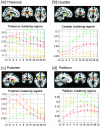Resting-state functional connectivity of the medial superior frontal cortex
- PMID: 21572088
- PMCID: PMC3236794
- DOI: 10.1093/cercor/bhr088
Resting-state functional connectivity of the medial superior frontal cortex
Abstract
The medial superior frontal cortex (SFC), including the supplementary motor area (SMA) and presupplementary motor area (preSMA), is implicated in movement and cognitive control, among other functions central to decision making. Previous studies delineated the anatomical boundaries and functional connectivity of the SMA. However, it is unclear whether the preSMA, which responds to a variety of behavioral tasks, comprises functionally distinct areas. With 24 seed regions systematically demarcated throughout the anterior and posterior medial SFC, we examined here the functional divisions of the medial SFC on the basis of the "correlograms" of resting-state functional magnetic resonance imaging data of 225 adult individuals. In addition to replicating segregation of the SMA and posterior preSMA, the current results elucidated functional connectivities of anterior preSMA-the most anterior part of the medial SFC. In contrast to the caudal medial SFC, the anterior preSMA is connected with most of the prefrontal but not with somatomotor areas. Overall, the SMA is strongly connected to the thalamus and epithalamus, the posterior preSMA to putamen, pallidum, and subthalamic nucleus, and anterior preSMA to the caudate, with the caudate showing significant hemispheric asymmetry. These findings may provide a useful platform for future studies to investigate frontal cortical functions.
Figures








References
-
- Alexander GE, DeLong MR, Strick PL. Parallel organization of functionally segregated circuits linking basal ganglia and cortex. Annu Rev Neurosci. 1986;9:357–381. - PubMed
-
- Assaf M, Calhoun VD, Kuzu CH, Kraut MA, Rivkin PR, Hart J, Jr, Pearlson GD. Neural correlates of the object-recall process in semantic memory. Psychiatry Res. 2006;147:115–126. - PubMed
-
- Berry KJ, Mielke PW., Jr A Monte Carlo investigation of the Fisher Z transformation for normal and nonnormal distributions. Psychol Rep. 2000;87:1101–1114. - PubMed

